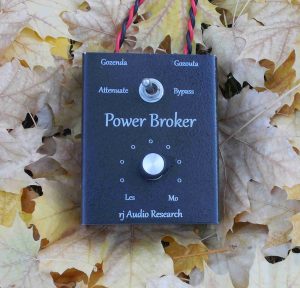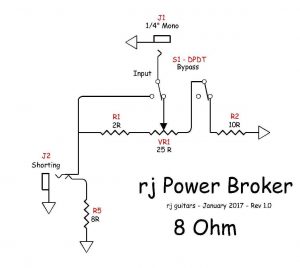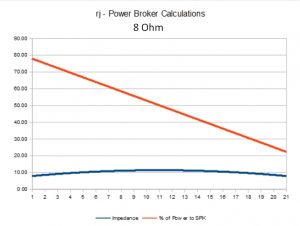rj – Power Broker Prototype

This was an idea that I came up with after years of studying the various forms of getting big guitar amp sounds at small volumes… the Holy Grail of amplifier design. My Power Broker is a resistive unit that essentially wastes away some significant portion of the amplifier output as heat and sends the balance to a speaker. This idea was not original on my part and is only my personal efforts toward making this technology simple and affordable for the DIY tone Junkies of the world.
To make my attenuator simple to use while maximizing the flexibility of it, I have created a couple unique features. The first is that I have integrated a large rheostat to allow a variable control of the power that is divided between the attenuator and the speaker. The 2nd is a bypass switch that entirely removes the attenuator circuitry from the path between the amp and the speaker.
I have never been especially pleased with the sonic results of “Power Scaling” or “Master Volume” controls, particularly with a high gain circuit like a TrainWreck Express. The typical problem I hear is that using these type of controls the distortion starts to sound thin and/or fizzy just about the point where you are getting the volume level down where it’s useful in a smaller venue. I think this is primarily caused by the physics that apply to vacuum tube operation when the these tubes are not working hard. Historically it’s believed that vacuum tubes sound best in guitar amps when they are being pushed toward the upper end of their operating parameters. Considering that it requires as much as a 90% reduction in power to reduce the audible sound level to half of it’s volume, this kills any chance that the tubes are working hard with a Variable Voltage Regulator (VVR) or Master Volume circuit dialing down the power output.

I believe the attenuator gives you a greater range of usable tone than either of these options. This keeps the power tubes working hard even when the volume level is not especially high. However, even an attenuated amp seems to lose the magic once you have dialed down the volume to what I’ll call the “Bed-Room” level.
This is due to some interesting characteristics of how our ears process sound. We seem to notice the loss of the higher and lower frequencies in a non-linear ratio as the sound level is reduced. Therefore a scaled representation of awesome loud tone does not necessarily sound the same to us at a lower volume level… some trickery is required but that is a topic for another day.

Resistors do not react to an audio signal in an equivalent way to a speaker so the use of an attenuator can impact what we are hearing. However, with the use of a resistive attenuator there is still a speaker in the circuit that helps to preserve some of the typical behavior of an amp plugged directly into a speaker cabinet. The resistive attenuator is an imperfect but generally satisfying mechanism for reducing volume without losing tone.
There are ways to emulate the behavior of a speaker in an attenuator, but typically they are expensive and complex. This design is neither complex nor expensive to build.
Ultimately, nothing sounds as good to our ears as “Loud” but this option gives us a decent alternative that will really help in getting great tone at a level that will help maintain relationships with small club owners, churches, other small venues, and your own family members.
Final Note – The use of a power attenuator will likely shorten the life expectancy of your amplifiers internal parts and those that use them should proceed at their own peril… great tone does not necessarily come cheap!